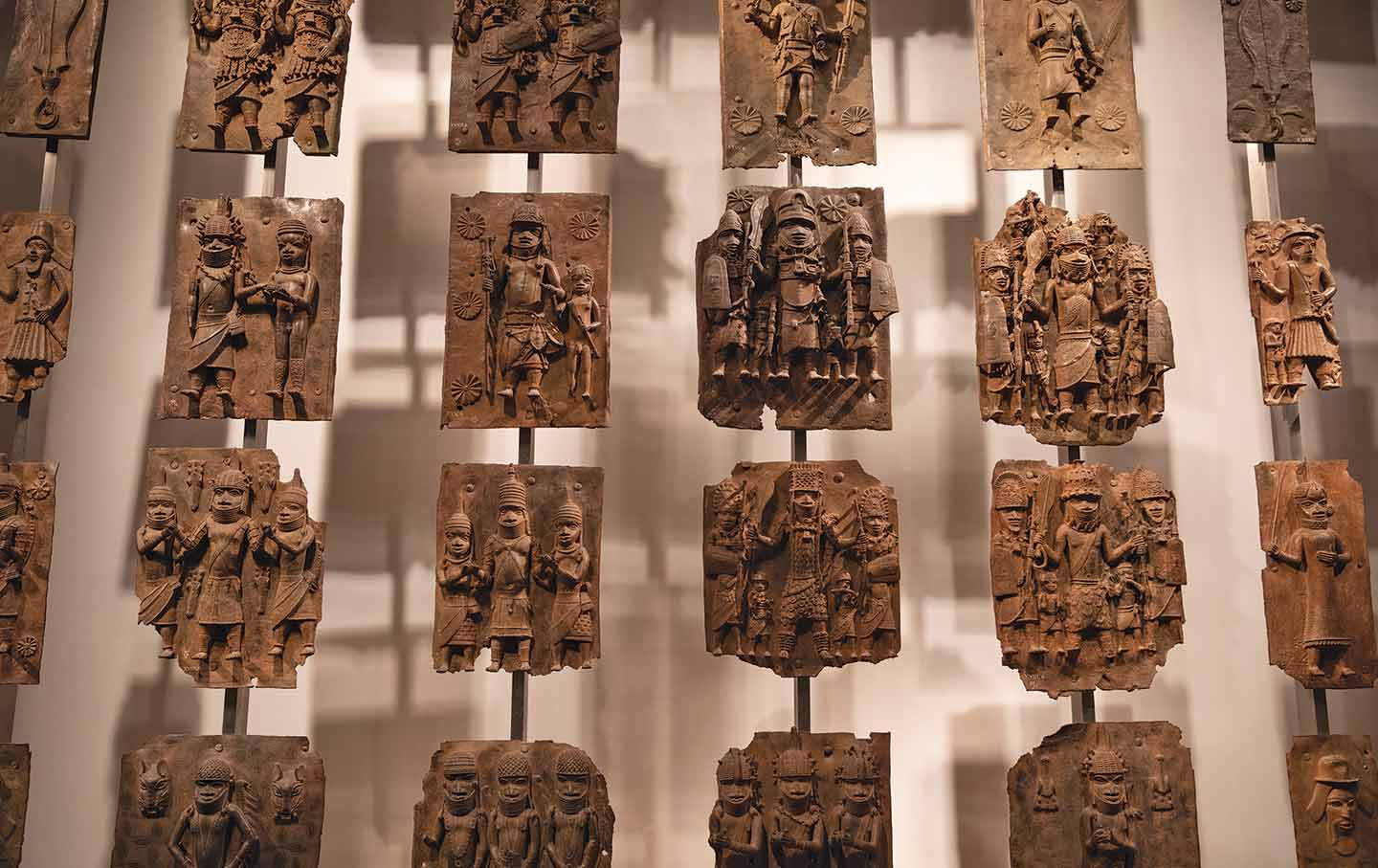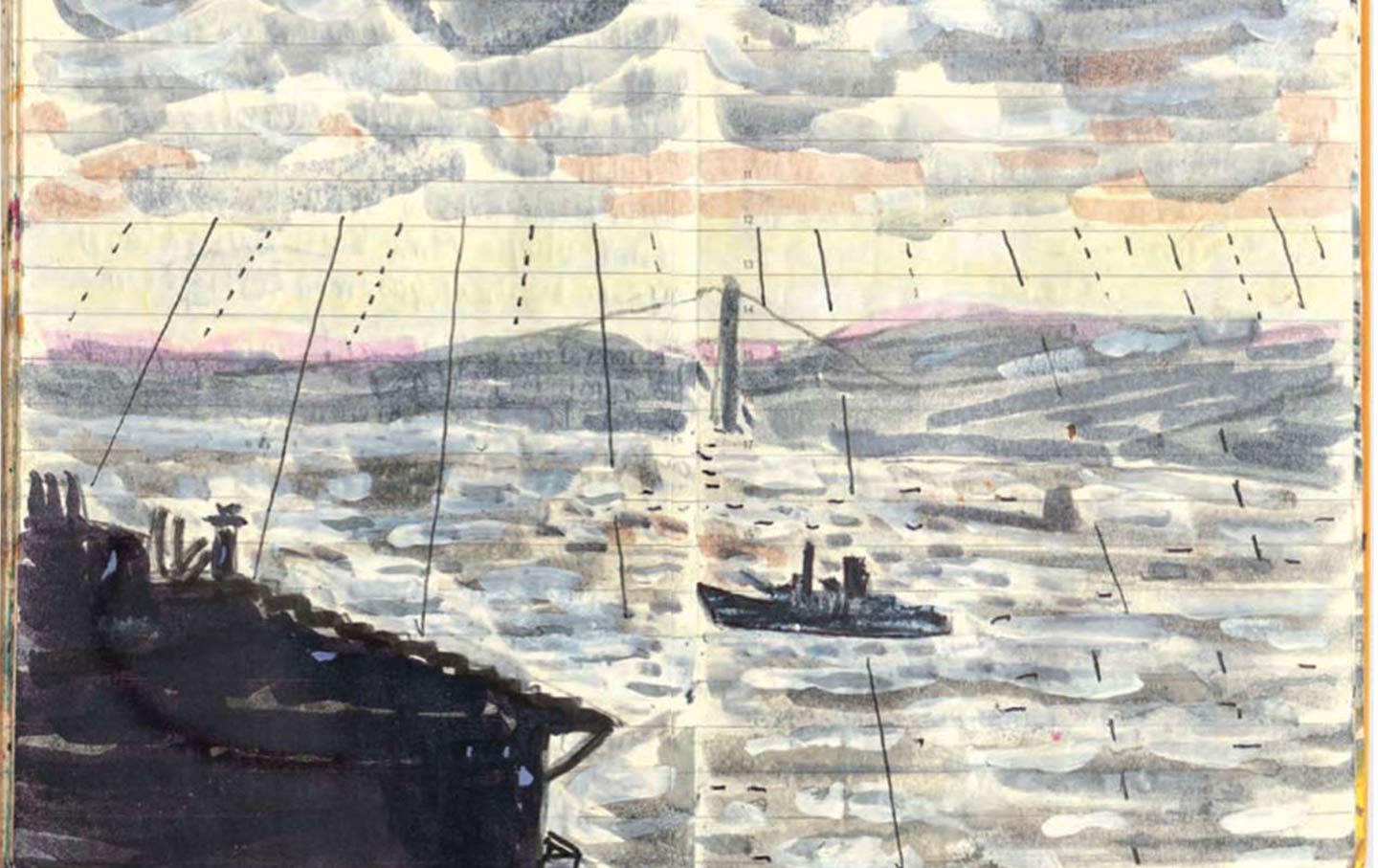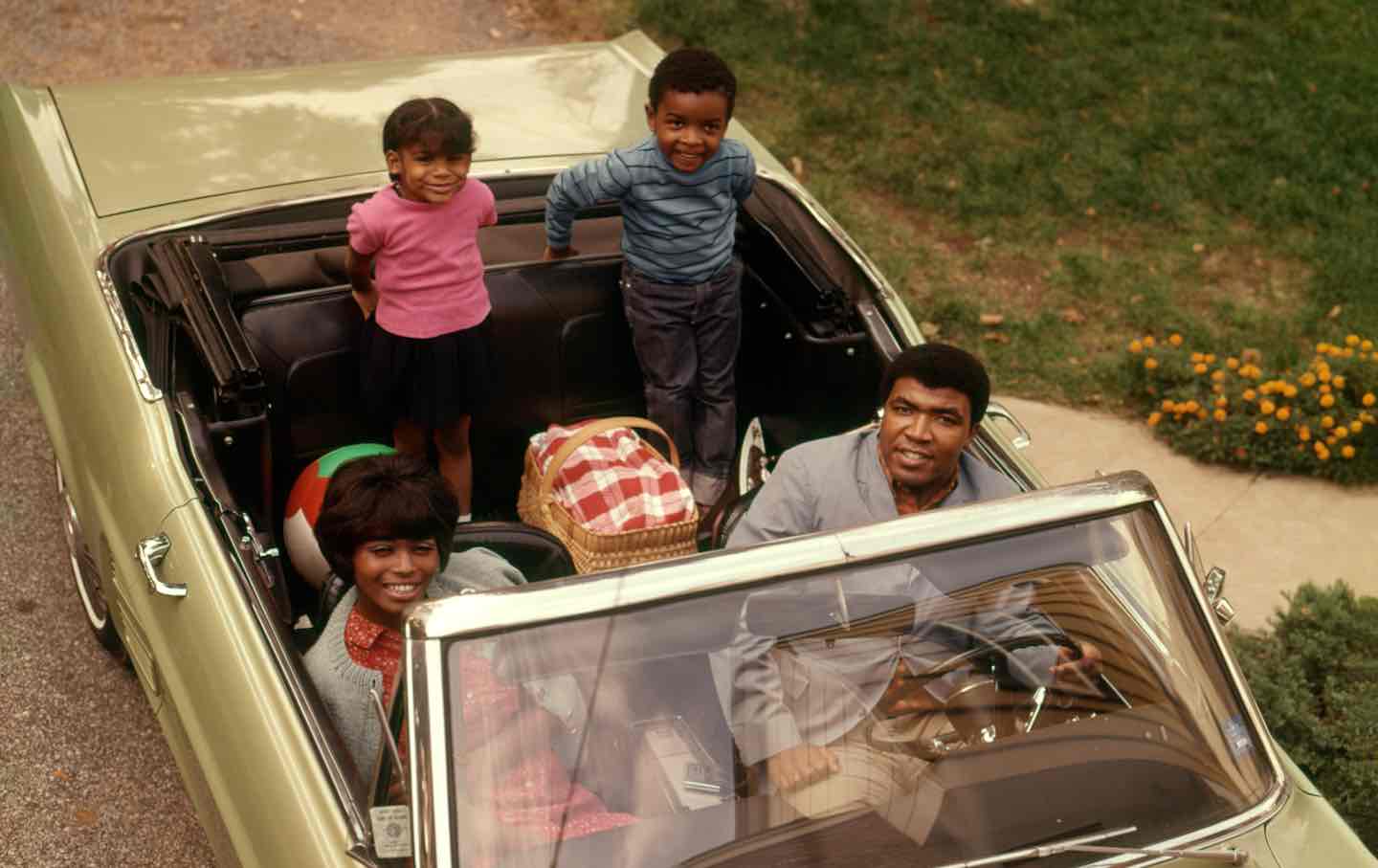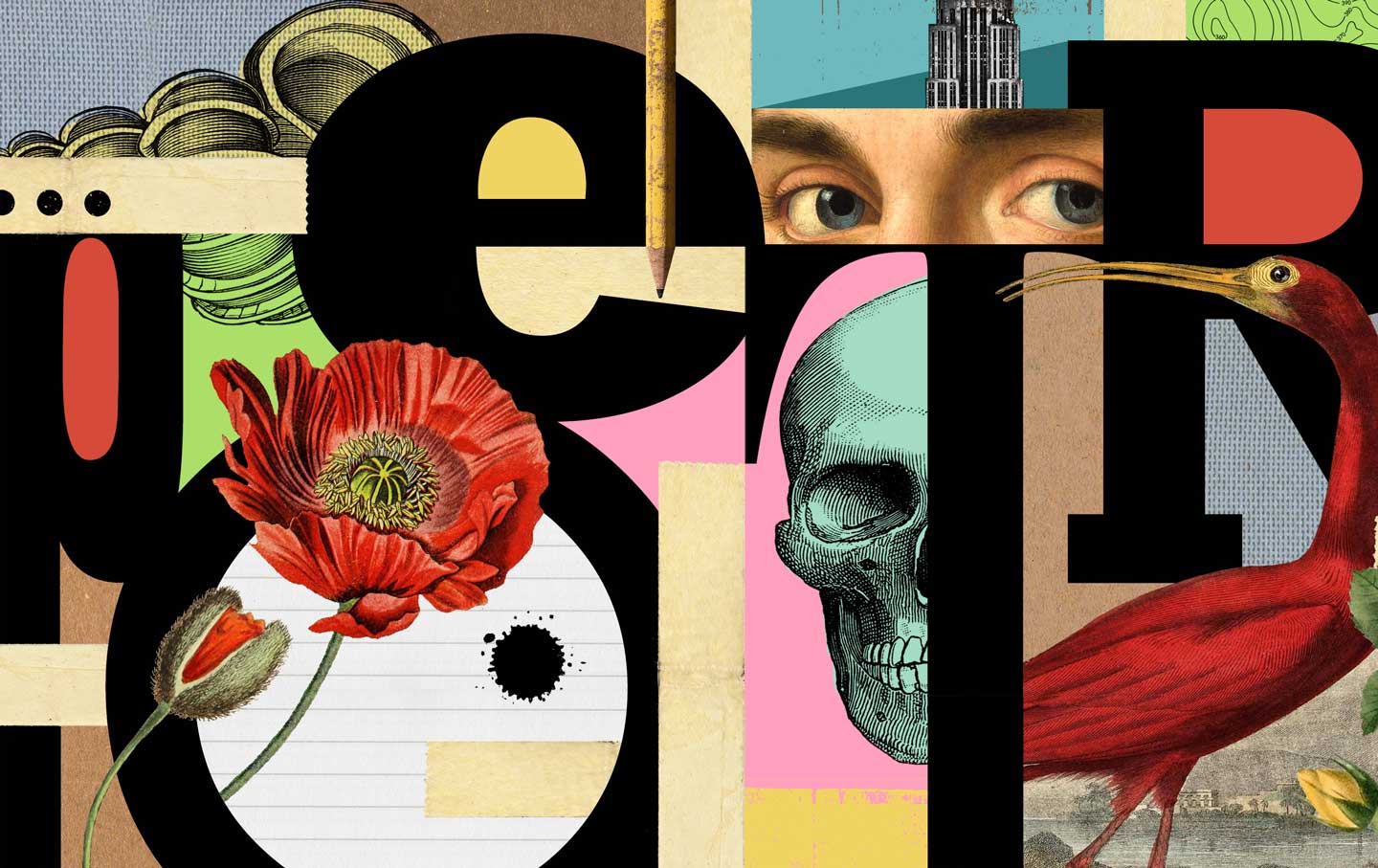Elsewhere Museums
Can the ethnographic museum be reinvented?
The Long History of the “Elsewhere Museum”
Can the ethnographic museum be reinvented?

Benin Bronzes at the British Museum.
(Dan Kitwood / Getty images)
In 1931, Paris hosted a spectacular event called the International Colonial Exhibition. Almost 8 million people visited the replica Angkor Wat, Moorish cafés, African mosques, and other highlights among the 200 or so pavilions set up for the occasion. Many families returned several times to experience an exotic round-the-world tour that lavishly reconstructed the architecture of France’s empire from Martinique to Indochina. There were foreign pavilions, too, that showed an imperial Denmark extending its reach to Greenland and Belgium displaying the embellished buildings of what was then known as the Belgian Congo. The French Surrealists, appalled by these displays, organized an anti-imperial counterexhibition months later at the French Communist Party’s headquarters. That event drew around 5,000 visitors—no small number, but vastly overshadowed by the millions visiting the Colonial Exhibition. When the latter closed, many of its objects ended up in the purpose-built Colonial Museum in the nearby Palais de la Porte Dorée, which soon became the Museum of French Overseas Territories and then, in the 1960s, the Museum of African and Oceanian Art. Since 2007, it has been known as the National Museum of the History of Immigration, a nod to the long historical thread connecting formerly colonized peoples with the country’s racialized minorities.
Books in review
The Museum of Other People: From Colonial Acquisitions to Cosmopolitan Exhibitions
Buy this bookThe names have changed, and yet amid these metamorphoses lies the permanence of what the anthropologist Adam Kuper calls “the museum of other people.” In an expansive new book by that title, Kuper retraces the making, undoing, and renewal of the West’s ethnographic museums. While the raison d’être for these collections is linked to the histories of empire, they have, Kuper argues, also found bold and original ways to tell the story of our colonial past and postcolonial present.
Kuper begins The Museum of Other People with the early cabinets of miscellaneous curiosities created during the Renaissance, and then proceeds to the more intentional collections and bequests with imperial or self-celebrating dimensions that defined the museum in the 19th and 20th centuries. But his real focus is on the ethnographic museum, which collects not merely human-made objects (as well as body parts) but also those originating from a fabrication: the notion of an entirely unknown elsewhere. While beginning as personal collections, these ethnographic institutions would eventually become public or quasi-public ventures, collecting “primitive” artifacts from territories that the West was colonizing. When the India Museum opened in London in 1801, it was populated with objects amassed by none other than the infamous British East India Company.
Kuper sketches the transformation of these museums from collections of personal curios to political actors in various European settings—Britain, France, the Netherlands, and Germany. He also considers their influence in North America through the establishment of such institutions as the Smithsonian and Harvard’s Peabody Museum.
Each of these ethnographic museums had a slightly different trajectory, shaped by the history of its home country’s empire. In the late 18th century, France was virtually at war with all of its neighbors when prominent voices in the country began calling for the expansion of the Louvre’s offerings via plunder and looting. One result of this was Napoleon Bonaparte’s seizure of Egyptian treasures during his military expedition in the Middle East, which an entourage of more than 150 scientists and artists tinted with a scholarly patina. Britain soon followed suit, obtaining the Rosetta Stone for the British Museum in 1802, where it remains to this day despite a campaign to “Repatriate Rashid” (the stone was taken from the Egyptian town of Rashid). As France’s imperial appetites grew, so did its collections of African, Oceanic, and Asian artifacts. The same was true of the British Museum, which was established to house the extensive collection of a single man, the Irish doctor and baronet Hans Sloane. Eclectic and poorly documented, Sloane’s collection reflected his personal tastes. But after several significant additional acquisitions and the museum’s expansion to Kensington, it became a museum of civilization, in which ethnographic rooms served to illustrate a prehistorical “primitiveness,” thereby providing a pretext for a linear, progressive interpretation of human history. Such museum displays and their interpretation directly communicated the emerging “scientific” theories that placed humans in racial hierarchies.
Around the same time, Charles Darwin published On the Origin of Species (1859), on evolutionary biology and the theory of natural selection. Applying the theory to humankind in The Descent of Man (1871), Darwin differentiated between civilized and uncivilized societies, indirectly rationalizing the West’s imperial ambitions and contributing to a new value for ethnographic items: They became the objects of “scientific” inquiry in addition to war booty or odd travel souvenirs.
Coursing through this new era of scientific interest and the institutions that housed its objects, Kuper notes, was a hierarchical and often racially defined understanding of human civilization. There was almost always a dichotomy—civilization versus savagery—that separated the various ethnographic items, and implicit in this opposition was the idea that those who fell on one side of it had the right to dominate the other.
The Smithsonian—founded in 1846 with a bequest from the British chemist and mineralogist James Smithson—was a parallel expression of the idea of manifest destiny, then justifying the conquest of North America’s Indigenous populations. The institution’s nascent team of ethnographers returned from their fieldwork with large hauls from the American West. Yet they were largely inexperienced, their training often as much military as scientific. The Smithsonian Bureau of Ethnology, Kuper notes, largely comprised “Civil War veterans who had taken part in the geological surveys. They had no background in ethnography or linguistics.”
The Smithsonian was not an exception but rather the rule for these kinds of museums. Their acquisitions were often the result of violent conquests by the nations of the West. The British plunder of the Summer Palace in Beijing helped to serve British opium interests, and the pilfering of the Benin Bronzes was the result of a British imperial expedition in Nigeria, though these are only two of the most astonishing examples of a general practice.
An effort to recover these plundered cultural objects is underway in many countries. Since the passage of 1990 Native American Graves Protection and Repatriation Act in the United States, institutions that receive federal funding have been pressed to return wrongfully acquired artifacts and human remains—craniums, skeletons, sexual organs, embryos, and more—to the communities from which they were extracted. Under the NAGPRA, these claims may involve more than 100,000 Native American remains kept in such institutions, among them Samuel G. Morton’s collection of more than 1,000 craniums housed at the University of Pennsylvania’s Museum of Archaeology and Anthropology. Earlier this year, the museum and the university agreed to bury the remains of 19 Black Philadelphians that were stored there. Yet more has to be done. Land acknowledgments and announcements to remove from view items considered offensive are not enough on their own.
In Europe, too, there have been attempts to return other people’s artifacts, again with mixed results. When French President Emmanuel Macron visited Burkina Faso in 2017, he announced that objects of African cultural heritage “cannot be held prisoner” in European museums, but the then-director of the Quai Branly Museum in Paris, which integrated the former ethnographic collection of the Musée de l’Homme in 2006, immediately rebuked the statement.
Macron soon commissioned a report, followed by a second, the latter led by Jean-Luc Martinez, the former director of the Louvre who has since been charged with “complicity of gang fraud and laundering” of antiquities. Since 2017, only 27 objects have been returned to African countries, mostly with a view toward strengthening diplomatic relations. The long-awaited release of a proposed restitution law was postponed until later this year, an unlikely prospect given the recent snap elections that resulted in a hung French Parliament, with strong gains by the far right. If the proposed law is aligned with the recommendations set out by Martinez in his nine restitution criteria, it may cover only claims made by countries (as opposed to communities) and exclude reparations, among other restrictions, but we have yet to see the political momentum needed to move this effort forward.
Britain has been no better. The Benin Bronzes still are in the UK, and the British Museum’s former keeper of Greek and Roman antiquities was suspected to have stolen or damaged more than 1,800 artifacts and sacked in July last year. As long as reparatory justice is seen as a zero-sum game in the museum world, the backlash will continue in the West. Meanwhile, ethnographic museums often remain unwilling to seriously confront their complicated pasts. The Smithsonian Institution—which includes 18 museums along with two more in development—is visited by more than 17 million people annually and has collections from Africa, Oceania, Asia, and the Indigenous peoples of North and South America, yet it still often presents these cultural objects as if they were produced by some far-off “others.” But Kuper finds some reasons for hope nonetheless. Citing identity museums such as those along the Mall in Washington, DC, he notes that this otherness can be turned on its head: Those who have been othered can now be the ones telling the story. For example, New York City’s El Museo del Barrio. Kuper also argues that the ethnographic museums, which already house millions of objects from around the world, might contribute to a more multicultural vision of humanity, one that “transcends ethnic and national identities, makes comparisons, draws out connections, [and] challenges boundaries.” Thus, the ethnographic museums can themselves be transformed. Culture has, after all, always relied on exchange; that one can view art from around the world in one’s native town is not a bad thing in itself, whether in New York City or in Abuja. It is how this art is collected and presented, and who gets to tell what stories, that matters in the end.
Support The Nation this Giving Tuesday
Today is #GivingTuesday, a global day of giving that typically kicks off the year-end fundraising season for organizations that depend on donor support to make ends meet and enable them to do their work—including The Nation.
To help us mobilize our community in this critical moment, an anonymous donor is matching every gift The Nation receives today, dollar-for-dollar, up to $25,000. That means that until midnight tonight, every gift will be doubled, and its impact will go twice as far.
Right now, the free press is facing an uphill battle like we’ve never faced before. The incoming administration considers independent journalists “enemies of the people.” Attacks on free speech and freedom of the press, legal and physical attacks on journalists, and the ever-increasing power and spread of misinformation campaigns all threaten not just our ability to do our work but our readers’ ability to find news, reporting, and analysis they can trust.
If we hit our goal today, that’s $50,000 in total revenue to shore up our newsroom, power our investigative reporting and deep political analysis, and ensure that we’re ready to serve as a beacon of truth, civil resistance, and progressive power in the weeks and months to come.
From our abolitionist roots to our ongoing dedication to upholding the principles of democracy and freedom, The Nation has been speaking truth to power for 160 years. In the days ahead, our work will matter more than it ever has. To stand up against political authoritarianism, white supremacy, a court system overrun by far-right appointees, and the myriad other threats looming on the horizon, we’ll need communities that are informed, connected, fearless, and empowered with the truth.
This outcome in November is one none of us hoped to see. But for more than a century and a half, The Nation has been preparing to meet it. We’re ready for the fight ahead, and now, we need you to stand with us. Join us by making a donation to The Nation today, while every dollar goes twice as far.
Onward, in gratitude and solidarity,
Katrina vanden Heuvel
Editorial Director and Publisher, The Nation
More from The Nation

Along the Roads That Built Modern Brazil Along the Roads That Built Modern Brazil
José Henrique Bortoluci's What Is Mine tells the story of his country’s laborers, like his father, who built its infrastructure, and in turn its fractious politics.

Rain and Mountains Rain and Mountains
Pages from a novelist’s notebook.

The Discontents of Michel Houellebecq The Discontents of Michel Houellebecq
What happened to the French novelist?

The Perils of a Post-Racial Utopia The Perils of a Post-Racial Utopia
In Nicola Yoon’s One of Our Kind, a dystopian novel of a Black upper-class suburb’s secrets, she examines the dangers of choosing exceptionalism over equality.

Why Americans Are Obsessed With Poor Posture Why Americans Are Obsessed With Poor Posture
A recent history of the 20th-century movement to fix slouching questions the moral and political dimensions of addressing bad backs over wider public health concerns.



